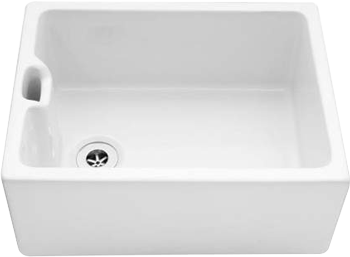Belfast sinks often create more of a focal point in a kitchen than many other sinks. The Belfast sink is a variation of the Butler sink; the only difference being that, traditionally, the Belfast had an overflow and the Butler had a shallower bowl with no overflow. Nowadays, both the Belfast and the Butler have overflows, although a weir overflow is only found on the Belfast sink.
 There has been a recent resurgence in the popularity of traditional kitchen sinks, which tend to be big and robust, and the Belfast has to be the main contender. Usually made from fireclay ceramic, though also available in stainless steel, these sinks are manufactured as a double bowl as well as the traditional single bowl, and can be purchased in white or cream. In addition to the traditionally square Belfast sink, there are variations such as the bow fronted and fluted front designs. Their simple shape, large bowl and ceramic finish make the Belfast sink easy to maintain and practical to use.
There has been a recent resurgence in the popularity of traditional kitchen sinks, which tend to be big and robust, and the Belfast has to be the main contender. Usually made from fireclay ceramic, though also available in stainless steel, these sinks are manufactured as a double bowl as well as the traditional single bowl, and can be purchased in white or cream. In addition to the traditionally square Belfast sink, there are variations such as the bow fronted and fluted front designs. Their simple shape, large bowl and ceramic finish make the Belfast sink easy to maintain and practical to use.
Belfast sinks are generally located beneath the work surface, whereby the front of the sink remains visible. Although these sinks are usually installed flush with the neighbouring cabinets and a slight overhang of the worktop, there are actually several ways of positioning them in order to achieve the most desirable look.
Belfast sinks combine well with most work surfaces, however, laminate worktops are not recommended due to the difficulty in sealing them, which leads to damage caused by water penetration.
All ceramic items can vary in size by up to 2%, due to their handcrafted design.
- Traditional in style
- Creates a charming focal point in the kitchen
- Large bowl
- Robust and practical
- Bow fronted and fluted front designs available
- Single and double bowl available
- White or cream ceramic colour options
- Stainless steel available
- Plumbing usually hidden within the kitchen cabinet
- Can be fitted in various ways to create a unique look
